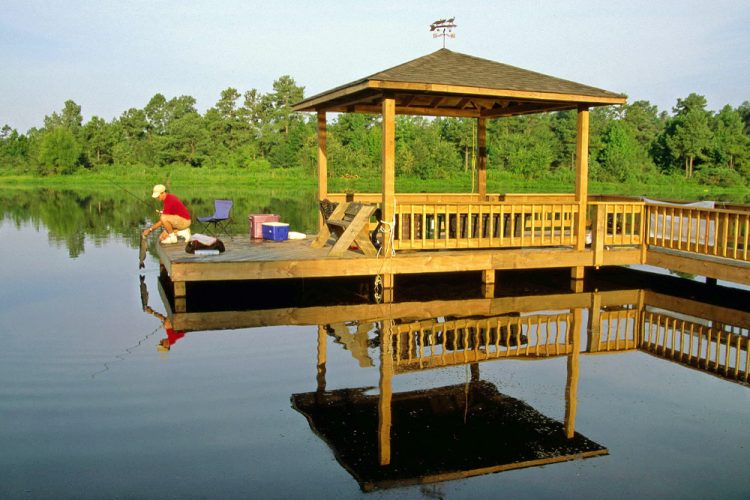A successful day on the water! Lifting a whiskerfish from the dock, proving the right spot makes all the difference. (Photo by Keith Sutton)
Catfish Basics #170—Finding a Place to Go Catfishing
Story and photo by Keith Sutton
How to pick a good spot where you can wet a hook for whiskerfish.
Catfishing is a great way to start your fishing journey—simple, relaxing and with plenty of opportunities to reel in some big catches. Whether you’re fishing from the bank of a pond or casting from a boat on a river, catfish are known for their fight and size, making them a favorite for anglers of all skill levels. In this guide, we’ll show you where to go catfishing and provide tips to help you find the best spots, so you can get out there and enjoy this rewarding sport, even if you’re just starting out.
Thanks to the internet, finding good catfishing spots is easier than ever. There are hundreds of websites packed with information about prime public fishing waters and the types of catfish you can catch in each. A few minutes spent on your favorite search engine (Google, Bing, etc.) should turn up many options.
State fish and wildlife agencies provide some of the best information. All 50 states have such agencies, and all the agencies have websites with fishing sections that include where-to-go information, including for catfishing. You can find links listed on the Association of Fish & Wildlife Agencies website at www.fishwildlife.org/landing/membership/member-list. Provincial agencies in Canada are listed there as well, along with organizations like the Recreational Fishing & Boating Foundation that can help in your search.
You’ll find useful info of all kinds on these websites, including descriptions of the fishing waters; interactive maps; locations of fishing piers, bank-fishing areas and boat ramps; fishing regulations; license information; weekly fishing reports; state and lake records; fish identification tips and much more.
Continue your internet search to find helpful information about the following catfishing destinations, too.
Family & Community Fishing Waters
State fisheries agencies often establish agreements with municipalities that allow them to manage small lakes and ponds to provide urban fishing opportunities. These waters usually are kept well stocked with fish, including catfish, and provide excellent bank fishing. Special fishing events, beginner fishing clinics and tagged fish contests often are offered by participating agencies, with a special emphasis on fishing activities for families, kids and retirees.
State Park Fishing Holes
Lakes, ponds and streams in state parks are worth learning about, too. Most are easy to fish, with good bank- or pier-fishing options. Rental boats often are available as well. Weekends and holidays may draw lots of visitors, especially in spring and summer, but during weekdays and cooler months, you often can enjoy fishing and other outdoor activities with few interruptions. Cast for catfish, then swap fishing tales by a campfire. Opportunities are many.
Federal Waters
Public catfishing opportunities abound on many federal areas, too. For example, our national forests and grasslands encompass more than 150,000 miles of streams and 2.5 million acres of lakes in 43 states where guests can enjoy superb catfishing opportunities. You can learn about them at www.fs.usda.gov.
Fishing is available at more than 270 national wildlife refuges and many other U.S. Fish and Wildlife Service lands and waters, too. Plus, the U.S. Army Corps of Engineers manages 12 million acres of lands and waters as part of its responsibilities, and many of that agency’s projects, most of which are near major metropolitan centers, include first-rate fishing facilities such as river- and lake-side walkways and trails, fishing piers, docks and launch ramps. Visiting the Corps Lake Gateway online (https://corpslakes.erdc.dren.mil/visitors/visitors.cfm) is a good way to start mining information.
Blue-ribbon catfishing in scenic settings also can be found in many national parks (www.nps.gov/fishing) and Bureau of Land Management areas (www.blm.gov/visit/fishing).
Private Waters
The catfishing locales discussed so far are all publicly owned, but many more great spots can be found on private land. Farmers, ranchers, and other landowners often build ponds, irrigation reservoirs, watershed lakes, livestock tanks, and other waters, and many are stocked with catfish, bluegills, and other fish. Fishing privileges often are reserved for family and special friends, but many times, if you ask permission in a courteous, direct manner, the owner will welcome you to visit and catch a few fish.
Be sure to follow all rules you’re asked to abide by, such as size limits or catch-and-release fishing only, and show respect for the landowners and their property. Close gates, don’t litter, and never damage fences or crops. Offer to share what you catch, and send a thank-you note afterward. If you act responsibly, you will probably be welcomed to fish again. If you don’t, you and fishermen who come after you may get turned down.



